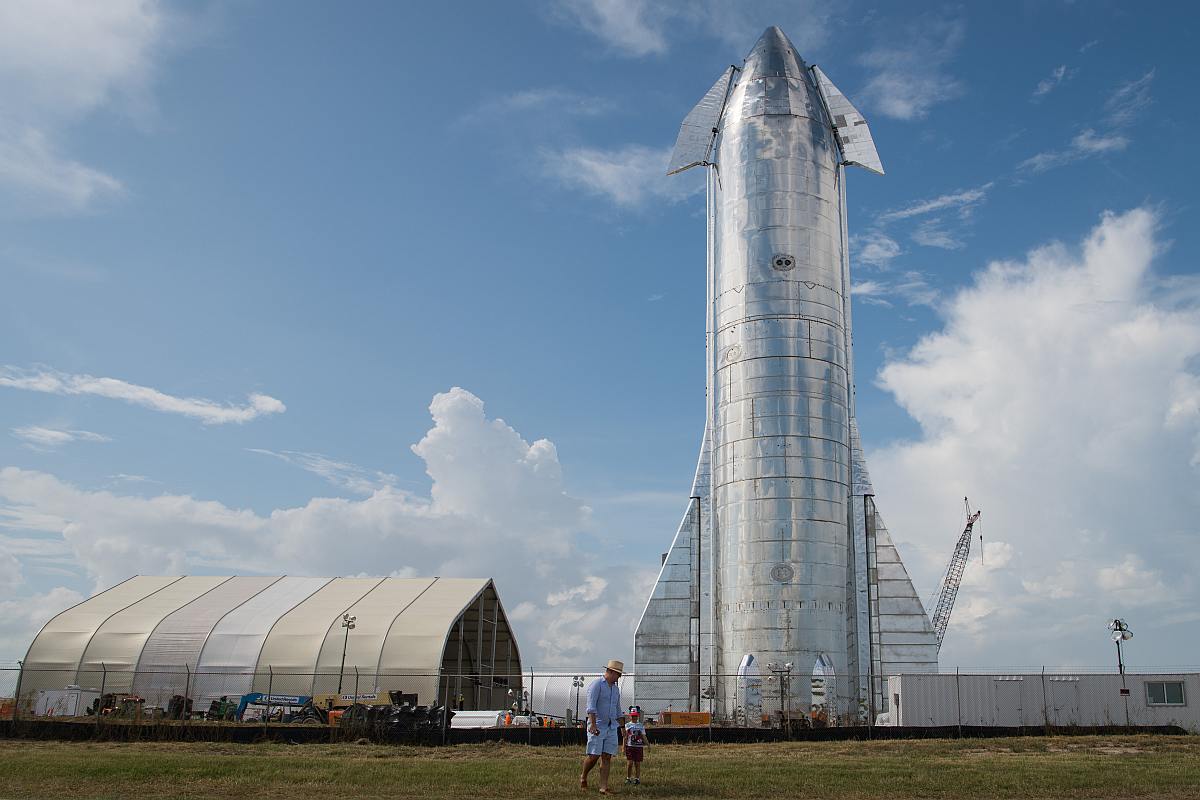Elon Musk visits China, likely to promote Tesla’s driverless tech: Report
Tesla CEO Elon Musk has made an "unannounced and surprising" visit to Beijing, according to a media report on Sunday.
A shiny steel rocketship designed to ferry dozens of humans to the moon and Mars, Starship is the top half of Musk’s colossal interplanetary rocket system that stands 387 feet tall (118 meters) as the latest addition to SpaceX’s lineup of reusable launch vehicles.

A prototype of SpaceX's Starship spacecraft is seen at the company's Texas launch facility on September 28, 2019 in Boca Chica near Brownsville, Texas. The Starship spacecraft is a massive vehicle meant to take people to the Moon, Mars, and beyond. (Photo: Loren Elliott/Getty Images/AFP)
SpaceX CEO and entrepreneur Elon Musk unveiled the latest updates to his space company’s newly assembled Starship on Saturday outlining a speedy development timeline for the centerpiece vehicle of SpaceX’s quest to launch humans to the moon and Mars.
SpaceX’s Starship and Super Heavy launch vehicle is a fully, rapidly reusable transportation system designed to carry both crew and cargo to Earth orbit, the Moon, Mars, and anywhere else in the solar system. On Saturday, September 28 at the launch facility in Cameron County, Texas, SpaceX Chief Engineer and CEO Elon Musk provided an update on the design and development of Starship.
Musk showed a crowd of space enthusiasts and reporters at SpaceX’s rocket development site late on Saturday in the remote village of Boca Chica, Texas, animations of Starship landing on the moon and Mars and predicted that the rocket’s first orbital flight could come in the next six months, followed by missions to space with humans aboard the next year.
Advertisement
Rage, rage against the dying of the light pic.twitter.com/aGRw4VowAQ
— Elon Musk (@elonmusk) September 28, 2019
Standing between a towering, newly assembled Starship rocket and Falcon 1, the company’s first vehicle whose debut orbital mission was celebrated by SpaceX 11 years ago.”This is basically the holy grail of space,” Musk said,
“The critical breakthrough that’s needed for us to become a space-faring civilization is to make space travel like air travel,” said Musk, who is also the chief executive of electric carmaker Tesla Inc.
A shiny steel rocketship designed to ferry dozens of humans to the moon and Mars, Starship is the top half of Musk’s colossal interplanetary rocket system that stands 387 feet tall (118 meters) as the latest addition to SpaceX’s lineup of reusable launch vehicles. Musk named Japanese billionaire Yusaku Maezawa as Starship’s first private passenger in 2018.
Starship will provide affordable delivery of significant quantities of cargo and people, essential for building Moon bases and Mars cities pic.twitter.com/0BImZP1qmM
— SpaceX (@SpaceX) September 29, 2019
The Boca Chica village, a few miles north of the Mexican border, is ground zero for SpaceX’s three-year experimental test program for Starship, whose rocket engine tests have rattled the nerves of residents living in a remote hamlet of roughly two dozen homes a mile away. “I think the actual danger to the Boca Chica village is low but it’s not tiny,” Musk said during a question and answer session. “So probably over time it’d be better to buy out the villages, and we’ve made an offer to that effect.”
Musk’s mission to the moon aligns with NASA’s goal of sending humans there by 2024 under its Artemis program, an accelerated deep-space initiative spurred by the Trump administration in March that aims to work with a handful of U.S. space companies in building a long-term presence on the lunar surface before eventually colonizing Mars.
The space agency has tapped SpaceX to figure out how to land vehicles on the lunar surface and help develop a system for refueling rockets — like Starship — in space, an “important technology to aid sustained exploration efforts on the Moon and Mars,” NASA said in a release on Friday.
NASA has awarded SpaceX and Boeing Co a total of $6.8 billion to build competing rocket and capsule systems to launch astronauts into orbit from American soil for the first time since 2011. Development of both astronaut capsules have been beset by delays and testing mishaps.
“I am looking forward to the SpaceX announcement tomorrow. In the meantime, Commercial Crew is years behind schedule,” NASA administrator Jim Bridenstine said in a Friday night statement. “NASA expects to see the same level of enthusiasm focused on the investments of the American taxpayer. It’s time to deliver.”
(With inputs from agencies)
Advertisement